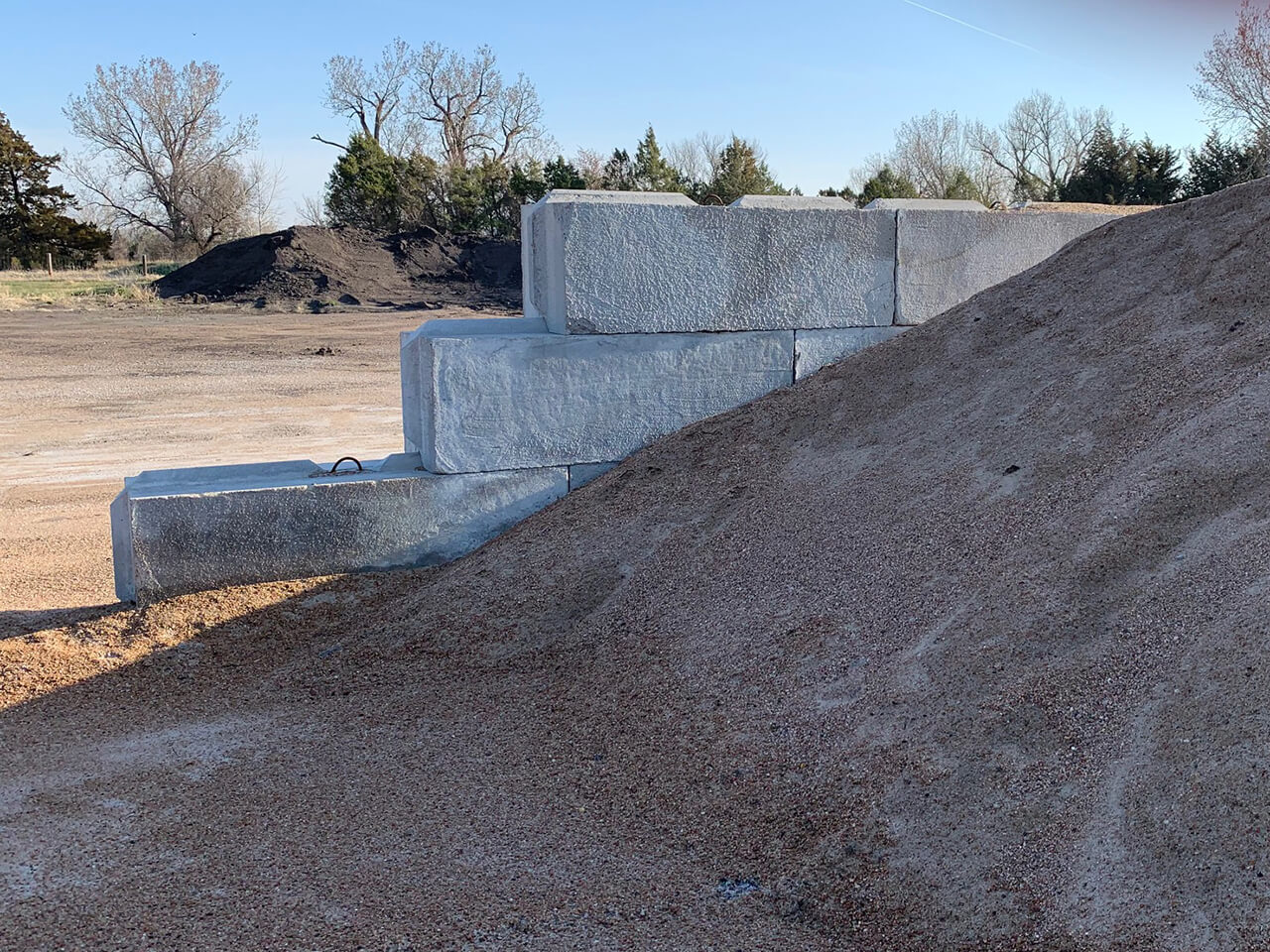Bin Blocks
Common Bin Block Uses
- sand, rock, or aggregate bin creation
- retaining walls
- barriers for parking lots
- restricted access to property
- a budget-friendly way to weigh down items
Bin blocks are built in a way that they easily interlock with adjoining units, allowing for flexible configurations, using full, half, and corner blocks.
These interlocking blocks make it possible to create material storage bins, retaining walls, landscaping features, and traffic barriers without extra supplies.
Other Names for Bin Blocks
You might also know bin blocks by other terms, such as:
- interlocking concrete blocks
- large concrete blocks
- concrete barrier blocks
- barrier blocks
- interlocking V-blocks
- ecology blocks
- large retaining wall blocks
- self-building concrete blocks
- storage blocks
- waste blocks
- mafia blocks
- jumbo concrete blocks
- bunker blocks
6′ x 2′ x 2′ Bin Block
Weight: 3500 lbs

3′ x 2′ x 2′ Half Bin Blocks
Weight: 1750 lbs

A Little More About Bin Blocks
Bin Blocks: you may have heard them called by another name.
The most unique thing about bin blocks is that each person and/or region uses different names for them. The most popular names are bin blocks, mafia blocks, barrier blocks, large concrete blocks, interlocking v-blocks, lego blocks, ecology blocks, gravity wall blocks, waste blocks, storage wall blocks, bunker blocks, and left-over concrete blocks.
If you are looking for a heavy object that cannot be easily moved, then you are looking in the right place.
In many applications, bin blocks are a much more cost-effective substitute for highway, or jersey, barriers. On personal property, these large concrete blocks are a great, cheap method to divert traffic. Whether placing bin blocks in areas along property to prevent unwanted people from parking there, putting them in front of a driveway to prevent people from using it, or surrounding parking lots to protect patrons dining outdoors from vehicles, concrete blocks are the most cost-effective concrete method there is. Weighing 3,500 lbs, they are not something people with bad intentions simply get out of their vehicle and move around by hand, making them a very effective solution to any parking or other traffic issues you may be experiencing.
One popular inquiry has been to buy something to prevent thieves from driving through the garage doors of facilities. Several business owners have called in a rush to buy barriers because they were paying security to sit at their buildings until the blocks were set in place.
There are plenty more traffic-diverting uses for bin blocks that have not been specifically mentioned here, which is why concrete bin blocks remain the most cost-effective concrete method there is.
For just a few bucks you can decrease your liability, and save yourself time no longer spent monitoring your property.
Just how cost-effective are they?
Customers frequently call to buy highway barriers, but after speaking with a representative about intended use, typically decide to use bin blocks instead. Highway, or Jersey, barriers sell from between $500 to $700, whereas large concrete blocks are available under $150.
Concrete Block Supply is ready to get you the blocks you need.
Concrete Block Supply offers a variety of bin blocks based on suppliers in your area. You can either drive right to the plant and the staff will load your trailer, or arrange for a flatbed truck to deliver the bin blocks to your job site. Just a reminder you will onsite equipment to off load the blocks.
Retaining wall information
A very popular use of precast concrete retaining wall blocks is to use them to form a cost effective retaining wall. At 6´L x 2Ẃ x 2´H and 3500lbs they make quick work of building a retaining wall. This type of retaining wall type is called a gravity wall because they use their own weight to hold the soil behind them. The first step is to measure out how long of an area by how high of an area you need to form your wall. Most flatbed trucks can ship 13 blocks at a time so any multiple of 13 will get you the best bang for your buck if you want the blocks delivered. You will begin by leveling out the area for your first row of blocks. Set your first row, making sure each block is firmly set and level. Once you set your first row the second row and beyond will go much faster. It is recommended that you offset the blocks so that the joints do not line up, this will offer you more strength at the joint. Most people only going a few blocks high choose not to use any type of geofabric because the weight of the large retaining wall blocks is enough to hold back the soil. Depending on your specific application and how high you are making your retaining wall you may want to put a mesh fabric in between your block row to offer your wall more resistance against the soil. This is up to you as Concrete Block Supply provides blocks and not engineered walls. Another thing to possibly consider is drainage. A layer of rock or gravel 8¨ – 12¨ works well. If you have a lot of moisture or a taller wall you may also need to install drainage pipe. In most areas the large retaining wall blocks are simply plain with a standard concrete finish, but in a few areas the blocks are offered with a brick or slate finish for a more appealing wall finish. Please keep in mind in all instances these retaining wall blocks are poured with extra concrete, they are not perfectly finished, which is why they are not $250+ each. The large retaining wall blocks Concrete Block Supply provides are the most cost-effective way to build a retaining wall but they are not the perfect fit for all applications.

